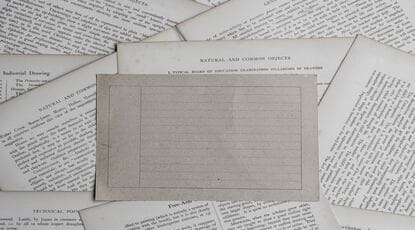A scientific abstract is a piece of writing that summarizes a research paper succinctly yet clear enough to allow the reader to know the content inside the article. Scientific abstracts are important because researchers read them first to determine whether or not the paper is relevant to their subject area and if to acquire it and read it. The abstract is the only part of a research paper that is availed to the participants of academic meetings and conferences. When you search through the electronic databases, you will realize that the abstract is the only part of a research paper that is available at no cost. In most cases, a scientific abstract is about two hundred to two hundred and fifty words. A scientific abstract comprises a title, information about the author (s), background, methodology used, study findings, and conclusions.
The first step to writing an informative scientific abstract is preparation.
Consider the following in the preparation phase:
Finish writing your research paper
Many authors usually write the scientific abstract last so that they capture the critical ideas mentioned in their article. In a scenario where an abstract is needed before you have completed your entire paper, such as for a conference, use an outline or a draft form of your article to come up with your abstract.
Go through your entire research paper
Take note of all the main points and write them down in a separate document. Once you have read the whole research paper, go through the points you highlighted and come up with content for your topic, research question, methodology, findings, and conclusion. Use the information you came up with to write your abstract.
Pay attention to keywords
Readers use keywords when searching for scientific abstracts in online databases. Identify the keywords that will help scholars to find your work with ease. Take note of them because you will use them when writing your abstract.

The second step to follow when writing your abstract is structuring it.
Below are the recommended structuring steps for your scientific abstract:
Discuss the background of your work
Use the content and keywords you derived from your paper to write a brief introduction (not more than three sentences) that explains your topic, the purpose of conducting the study, and the research question. The first sentence should be catchy to attract the reader’s attention to your work. The background is the shortest part of your abstract and should provide information that is already known about that subject matter and demonstrate how it is related to your work. The background also reveals what the reader does not know about that subject, therefore, helping them to understand what the paper is all about.
- Look at your paper as an investigative tool of a specific scientific question. With that mindset, you will appreciate the fact that other researchers have interest in your research question.
- Your background should provide a satisfactory response to the following questions. What did I learn/discover? What is the significance of my research question? What was known in my field of study about the research question before I embarked on this research? How will this study I am undertaking add to my field of study?
- Use of active voice when writing your scientific abstract.
- Avoid using pronouns such as “I” or “we.” Instead, use words like “this research,” “this paper discusses,” “my research,” etc.
- Write your scientific abstract in the past or present tense. Do not use the future tense. For example, do not write “This study will evaluate” but “this study evaluates.”
Talk about your methodology
Discussing the methods you used to conduct your research and the steps you undertook comprise the longest part of the scientific abstract and is about 2-3 sentences long. State whether the methodology was quantitative or qualitative. The methodology can be surveys, interviews, data analysis, laboratory experiments, ethnographic fieldwork, etc. Your methods should provide content that addresses the following questions adequately.
What research design did you use?
What was the duration of your research?
What is your choice of sample size?
How did you choose the participants of your study?
Where did your research take place (the research setting)?
Mention the findings of your study
Discuss the results of your research in 1-2 sentences. Include qualitative and quantitative results and any trends that you identified. The results section is the most crucial part of the scientific abstract because it reveals what was uncovered by your work and the relevance of your study to other previous work. As such, provide adequate elaborations and details in this part.
Finish with the conclusion
It should capture critical ideas and should tell the reader the significance of your study. Restate the summary of your research and its conceptual or practical bearing on the study area. Mention whether your work has bridged the knowledge gaps in that field. Your conclusion should be based on relevant data and facts. Avoid personal opinions that are not evidence-based at all costs. Wrap up your writing with a strong conclusive statement.
Come up with a title for your scientific abstract
The title of your scientific abstract should capture the content in your abstract. It should persuade your readers to believe that the topic is pertinent, of great value, and original. You can use the title of your abstract for your research paper. Mention your name, the institution you are affiliated with, and your contact information below the title.
In some cases, a particular format might be needed for the title, such as the use of italics, uppercase letter, or bold depending on the preference of an organization, conference, or journal.

The last step when writing a scientific abstract is looking at the style and flow of your work.
Follow the style and flow below:
Read your scientific abstract aloud and ascertain that there is flow and accuracy in your work. The information provided in your scientific abstract should flow smoothly. Use transitional phrases such as “moreover” when moving from sentence to sentence. Ensure that your sentences are meaningful and convey your findings accurately. When going through your abstract, adopt the mindset of another person. Ask yourself whether you would want to read the paper if you were another researcher. Putting yourself in the shoes of your reader(s) will help you to determine if your abstract is satisfactory enough to warrant readership. That way, you can spot any gaps with ease.
Proofreading your scientific abstract is essential
Always go through your work to check for any punctuation, spelling, or grammatical mistakes. You can use any approach to edit your work. You could print it out and correct with a pen or you could edit it from your computer. However, it is advisable to print it out to give your eyes a ‘fresh’ look as they may be numb for continually looking at your computer screen. A good writing style will appeal to your readers. As such, ensure that you use the correct mechanics of writing and grammar.
- Use punctuation marks appropriately. For example, place periods and commas within quotation marks.
- Avoid using prepositions at the end of your sentences.
- Do not repeat the same nouns and verbs many times. Ensure there is variation in your use of verbs and nouns.
- Do not use vague adjectives such as “many” and “very.” Instead, quantify your results using specific data that provide comparisons.
- Do not use apostrophes for written years. Therefore, write “1850s” instead of “1850’s”.
- Fish out irrelevant detail from your work. Add information if there are any gaps.
Check the word count of your scientific abstract
It should not be too lengthy or too short. A word count of 200 or 250 words is recommended. Adhere to the appropriate word count because some conferences and journals reject lengthy abstracts.
Ask a friend or colleague to go through your work
When another person reviews your work, they can spot any errors that you did not see or note parts that require adjustments that you initially thought were okay. Additionally, their input will help you to assess whether your scientific abstract makes sense to possible readers.
Discover more useful guides from our blogs:
How to write an accurate research paper outline
Tips for writing a succinct thesis statement
How do you write a dissertation literature review?
By All Researchers
Need help with this assignment or a similar one? Place your order and leave the rest to our experts!
